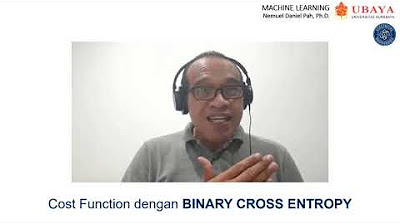Making AI More Accurate: Microscaling on NVIDIA Blackwell
Summary
TLDRThe script discusses the advancements in machine learning quantization, highlighting the shift towards lower precision formats like FP6 and FP4 to accelerate computation. It emphasizes the challenges and potential of these formats, particularly in inference and low-power devices. The introduction of microscaling by Nvidia is noted as a significant development, allowing for efficient scaling of the number line to maintain accuracy. The need for standardization in these reduced precision formats is also stressed, as the industry awaits clear guidelines for implementation.
Takeaways
- 📈 In machine learning, quantization involves using smaller numbers to increase computational efficiency.
- 🔢 The adoption of reduced precision formats like FP16, BFloat16, and INT8 has become popular for speeding up computations while maintaining accuracy.
- 🌟 Nvidia's Blackwell announcement introduced support for FP6 and FP4 formats, aiming to further accelerate math workloads by using fewer bits.
- 🚀 Despite the limited representation of numbers in FP4 (2 bits for the magnitude), it's believed that these formats can still be sufficient for certain machine learning tasks, especially inference.
- 🔍 Ongoing research is needed to confirm the accuracy of low-precision formats like FP6 and FP4 for everyday use.
- 📊 Microscaling is a technique that allows for better utilization of reduced precision formats by adjusting the scaling factor, which was initially introduced by Microsoft as MSFP12.
- 🔧 Microscaling enables a range of numbers to have their accuracy and range scaled to a specific region of interest, which is crucial for maintaining precision in calculations.
- 🛠️ Nvidia's approach to microscaling supports a larger number of FP4 values with a single 8-bit scaling factor, improving efficiency.
- 📈 The industry is moving towards standardized reduced precision formats, but the rapid pace of machine learning advancements presents challenges for standardization bodies like IEEE.
- 👨💻 For programmers working with fundamental mathematical operations, the complexity and rapid evolution of reduced precision formats present a high barrier to entry.
- 🎯 Clear guidelines and industry consensus on the implementation and usage of reduced precision formats are essential for their successful adoption and to maximize their potential benefits.
Q & A
What is the purpose of quantization in machine learning?
-Quantization is a process that allows the use of smaller numbers or bits to increase computational efficiency, which can lead to faster computation and reduced memory usage while maintaining accuracy, particularly for machine learning tasks.
What are the benefits of using reduced precision formats like FP16, bfloat16, and INT8?
-Reduced precision formats offer substantial speedups in computation while maintaining the same level of accuracy. They enable faster processing of large datasets and models, which is crucial for machine learning applications, especially in resource-constrained environments.
What new formats did Nvidia announce in their latest GTC event?
-Nvidia announced support for FP6 and FP4 formats, which are floating-point precision in six bits and four bits, respectively. These formats aim to further increase the number of operations that can be performed, especially for machine learning and inference tasks.
What is the main challenge with using FP4 format for machine learning?
-The main challenge with FP4 format is that it has only four bits to represent a number, with one bit for the sign and one for indicating infinity or not a number. This leaves only two bits to cover the entire range of numbers, which limits the precision and the number of operations that can be performed.
How does microscaling help in addressing the limitations of reduced precision formats?
-Microscaling involves using an additional set of bits, typically eight bits, as a scaling factor. This allows the representation of a range of numbers with greater precision within a specific interval, effectively expanding the dynamic range and improving the accuracy of computations in reduced precision formats.
What is the significance of the work done by Microsoft in the context of microscaling?
-Microsoft introduced the concept of microscaling in their research, which was first implemented in a format called MSFP12. This innovation allows for the scaling factor to be applied to multiple values, reducing the overhead and making reduced precision formats like FP4 more practical and efficient for machine learning tasks.
How do processors like Tesla Dojo and Microsoft's Maya AI 100 chip utilize scaling factors?
-These processors support scaling factors that can be applied to a range of values within a machine learning matrix. By doing so, they can perform operations across a large number of values with a single scaling factor, enhancing efficiency and performance in computations.
What is the role of the IEEE standards body in the development of precision formats?
-The IEEE standards body is responsible for establishing and maintaining standards for various data formats, including floating-point precision formats like FP64 and FP32. They are also working on standards for 16-bit and 8-bit precision formats to ensure consistency and compatibility across different architectures and applications.
What are the implications of the diversity in reduced precision formats across different architectures?
-The diversity in reduced precision formats can lead to inconsistencies in mathematical operations and handling of special cases like infinities and not-a-numbers (NaNs). This can make it difficult to manage and ensure the correctness of computations across different hardware and software platforms.
Why is it important for the industry to come together and define clear standards for reduced precision formats?
-Clear standards are essential for ensuring compatibility, efficiency, and correctness across different platforms and applications. They help developers and programmers to understand and effectively utilize reduced precision formats, leading to better performance and more reliable machine learning models.
How can programmers and developers overcome the challenges associated with reduced precision formats?
-To overcome these challenges, programmers and developers need clear guidelines and documentation on the implementation of reduced precision formats. They may also need to engage with more specialized frameworks and tools beyond common ones like TensorFlow and PyTorch to extract the maximum performance benefits from these formats.
Outlines

This section is available to paid users only. Please upgrade to access this part.
Upgrade NowMindmap

This section is available to paid users only. Please upgrade to access this part.
Upgrade NowKeywords

This section is available to paid users only. Please upgrade to access this part.
Upgrade NowHighlights

This section is available to paid users only. Please upgrade to access this part.
Upgrade NowTranscripts

This section is available to paid users only. Please upgrade to access this part.
Upgrade Now5.0 / 5 (0 votes)





